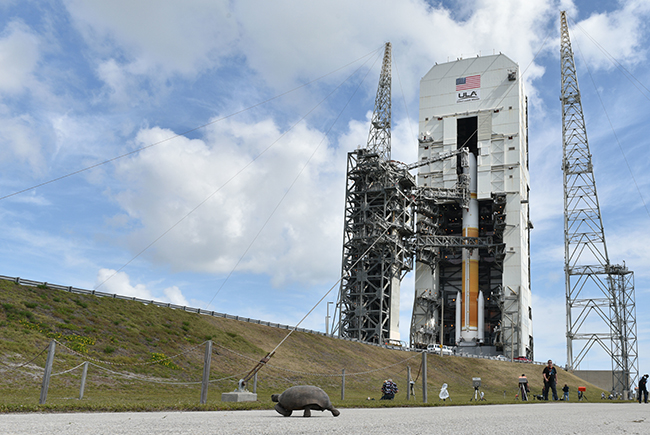
The United Launch Alliance prepares the Delta IV rocket Wideband Global SATCOM WGS-10 satellite at Cape Canaveral AFS, Fla., Complex 37 on March 15, 2019. Air Force photo by A1C Dalton Williams.
COLORADO SPRINGS, Colo.—Three of the companies vying for two spots in the second phase of the Air Force’s National Security Space Launch program next year disagree about whether the service should delay its final request for proposals.
A Northrop Grumman official said Monday he’d prefer the Air Force speed up the competition, while United Launch Alliance Chief Executive Officer Tory Bruno is comfortable with the pace and Blue Origin CEO Bob Smith is arguing for a delay.
Kent Rominger, Northrop’s vice president for strategic programs, said the program is progressing as it should be, and could even be accelerated. He noted the company could cut several months out of the schedule if needed. But Rominger doesn’t expect that the Air Force’s certification timeline for three NSSL entrants—who expect test flights in the early 2020s—puts anyone at a disadvantage.
“When they did the original [Evolved Expendable Launch Vehicle] program, back then they selected two companies … Lockheed Atlas V, Boeing Delta IV,” he said. “They weren’t near as far along on their systems as we are now, so there’s a history of that and it all works.” Lockheed and Boeing joined forces and formed a consortium in 2006 known as the United Launch Alliance.
Bruno echoed that idea during a media briefing Monday at the 35th Space Symposium here.
“The schedule that the Air Force has put together is part of a large acquisition that was very thoughtfully put together and is the fastest path to end US dependency on the Russian RD-180 rocket engine, so let’s get on with it and get it done,” he said.
But Blue Origin’s Smith seemed to side with concerns that House Armed Services Committee Chairman Rep. Adam Smith (D-Wash.) raised in a March 28 letter to Air Force Secretary Heather Wilson. He noted the service seems to be rushing its procurement after slowing the launch services development process, like pushing back contract awards from July to October 2018.
“The first test launch of the new vehicles under development for category A and B [intermediate rockets] would not occur until FY21 and national security launches would not occur until FY22,” Adam Smith wrote. “If the Air Force does not procure additional Delta Heavy vehicles, the first category C heavy vehicles are not needed until 2025.”
“Further, the Air Force seems to have acknowledged that delays in development are likely, as language recently added to the Phase 2 Draft RFP allows offerors to use ‘alternative launch vehicle solutions’ for launches through 2023 if the new launch vehicles … are not ready,” he continued.
While the Air Force wants to choose two companies for Phase Two next year, Northrop’s OmegA, ULA’s Vulcan Centaur, and Blue Origin’s New Glenn launch vehicles will not yet have completed their two test flights needed for certification. SpaceX, whose Falcon 9 and Falcon Heavy certifications are under review, can also bid on the second phase despite not having received a USAF launch vehicle development contract like the other three companies last year.
“We think competition is good and we welcome competition,” said Bob Smith, the head of Blue Origin. “We really want to make sure that we have … actual hardware that we can actually go evaluate. It just seems premature.”
The Air Force could push off the final RFP to get better insight into its options, he added.
“These are big one-way-door decisions that we have for the nation and what infrastructure we put down and how we put that down is important,” Smith continued. “More time would actually be beneficial.”
A final RFP, believed to evaluate the offers based on technical merit, company stability, cost, and other factors, is expected out this spring.
Bruno told reporters ULA’s certification plan includes two test flights for the Vulcan’s medium variant in 2021 and heavy flights in 2023 for certification a year later.
Blue Origin and Northrop are both offering their own launch vehicles for the NSSL program, but each will also provide rockets for ULA’s Vulcan design. Smith, speaking Monday as a member of the ULA team rather than in his Blue Origin capacity, did not discuss New Glenn’s progress.
Northrop is working toward test firing the first stage of its OmegA rocket’s engine on May 31, followed by the second stage in August, according to Rominger.
The company will flight test its OmegA system twice in 2021 to be able to declare initial operational capability in 2022, when the rocket will be capable of carrying payloads. The entire upper stage is headed to vacuum-chamber testing in late 2020 or early 2021, another big milestone. OmegA is expected to be certified in mid- to late 2021, with heavy rocket certification slated for 2024.
“We’ve designed this whole system, certainly the intermediate, … to be developed very quickly, low risk, and meet all the performance needs,” Rominger said.
The company will work through its major critical design reviews this summer and in early fall for launch-services components like the upper stage tank and the launch system, he said.
“My interest is either pulling everything left or building more margins so if we do encounter challenges, we execute on time,” he told Air Force Magazine.
If the service does delay the Phase 2 RFP, Rominger said it wouldn’t affect Northrop’s progress or its supply chain at this point, but he argues the Air Force can’t afford to push its choice off any more.
He noted Northrop is in talks with NASA about possible uses for OmegA now, and can also explore commercial opportunities, though he acknowledged that sector can be unpredictable.
SpaceX did not respond to a request for comment Monday.